Cholesterol Reduction Calculator
Your Current Situation
Combination Therapy Options
Most people on statins don’t need a higher dose. They need a second pill. That’s the quiet revolution happening in cardiology right now - and it’s changing how we treat high cholesterol.
For years, the default move when LDL cholesterol stayed too high was to crank up the statin dose. Double it. Triple it. But here’s the problem: doubling the statin dose doesn’t double the effect. In fact, it barely moves the needle. A 2023 analysis in the Journal of the American College of Cardiology showed that going from 10mg to 20mg of atorvastatin only lowers LDL by an extra 6%. That’s the rule of six - and it’s why so many patients still aren’t hitting their targets, even on high doses.
Why Higher Statin Doses Don’t Work Like You Think
Statins work by blocking cholesterol production in the liver. But your body has backup systems. Once you hit a certain dose, your liver just ramps up production to compensate. That’s why going from moderate to high-intensity statin - say, from atorvastatin 20mg to 80mg - only adds about 6% more LDL reduction. You’re paying more in side effects, not results.
Side effects are the real kicker. About 1 in 10 people on high-dose statins report muscle pain, fatigue, or weakness. For some, it’s mild. For others, it’s enough to quit entirely. Studies show up to 50% of patients stop taking high-dose statins within a year - not because their cholesterol is fine, but because they can’t tolerate the pill.
And here’s the irony: those same patients are still at high risk for heart attacks and strokes. Their LDL is too high. Their arteries are still clogging. But they’re off the meds.
The Alternative: Combine, Don’t Increase
What if you could get the same LDL reduction with half the statin dose - plus fewer side effects?
That’s where combination therapy comes in. Instead of pushing statins to their limit, doctors now pair a moderate statin with a second, non-statin drug. The two work together in different ways to lower LDL. The math isn’t additive - it’s multiplicative.
Let’s say you’re on atorvastatin 20mg. That gives you about a 40% drop in LDL. Add ezetimibe, a simple daily pill that blocks cholesterol absorption in the gut, and you get an extra 20% reduction - but not on top of the 40%. It’s 20% of what’s left. So 40% + 20% of 60% = 52% total reduction. That’s better than high-dose statin monotherapy (which maxes out around 50%) - and with a much lower statin dose.
Real-world data backs this up. A 2025 meta-analysis of nearly 19,000 patients found that statin plus ezetimibe lowered LDL by 23.7 mg/dL more than doubling the statin dose. And 28% more patients hit their target LDL levels. No extra muscle pain. No extra side effects. Just better results.
Who Benefits Most?
This isn’t for everyone. But for certain high-risk groups, it’s becoming the new standard.
- People with established heart disease - especially those who’ve had a heart attack or stroke. Their target LDL is often below 55 mg/dL. Few can hit that with statins alone.
- Those with familial hypercholesterolemia - a genetic condition that spikes LDL from birth. These patients often need triple therapy just to stay alive.
- Statin-intolerant patients - about 1 in 5 statin users. For them, switching to a lower-dose statin plus ezetimibe can mean staying on treatment instead of quitting.
A case from Cleveland Clinic in 2022 tells the story: a 68-year-old man had a heart attack. He was on atorvastatin 80mg - his LDL was still 82 mg/dL. He had muscle pain. His doctor dropped the statin to 40mg and added ezetimibe. Within weeks, his LDL dropped to 64 mg/dL. The muscle pain vanished. He’s still on it two years later.

What About Other Drugs? Bempedoic Acid and PCSK9 Inhibitors
Ezetimibe is cheap, generic, and well-tolerated. But sometimes, it’s not enough.
For patients who need even bigger drops - say, LDL below 50 mg/dL - doctors add bempedoic acid or PCSK9 inhibitors. Bempedoic acid works in the liver like a statin but doesn’t enter muscle tissue, so it’s much gentler. A 2019 trial showed moderate-dose statin plus bempedoic acid lowered LDL as much as high-dose statin alone - but with 25% fewer muscle side effects.
PCSK9 inhibitors (like evolocumab and alirocumab) are injectables that slash LDL by 60%. Used with a high-dose statin, they can drop LDL by 80% or more. But they’re expensive. In the U.S., they cost $14,000 a year. Insurance often blocks them unless you’ve tried everything else. Still, for people with genetic cholesterol disorders or recurrent heart events, they’re life-saving.
Why Isn’t This the Default?
If it’s better, safer, and more effective - why aren’t all doctors using it?
Guidelines lag. The 2013 ACC/AHA guidelines called combination therapy an option for statin-intolerant patients - but didn’t recommend it upfront. European guidelines still say to try high-dose statins first. Most primary care doctors aren’t trained to think in multiplicative terms. They’re used to “if one pill doesn’t work, give more.”
Insurance is another barrier. Ezetimibe is cheap, but prior authorizations can delay it by two weeks. PCSK9 inhibitors? Forget it - you’ll need to appeal three times.
A 2023 study in JAMA Internal Medicine found only 25% of eligible patients got combination therapy - even when their LDL was far above target. The rest kept getting higher statin doses… and quitting.

What Should You Do?
If you’re on a high-dose statin and your LDL is still too high - talk to your doctor about switching to a lower dose plus ezetimibe. Ask: “Could adding a second drug help me reach my goal with fewer side effects?”
If you’ve stopped statins because of muscle pain, ask about bempedoic acid or ezetimibe. You might be able to get back on treatment without the discomfort.
If you’ve had a heart attack or stroke and your LDL is above 70, you’re in the high-risk group. Combination therapy isn’t optional - it’s essential. The data is clear: every 1 mmol/L (39 mg/dL) drop in LDL reduces your risk of heart attack or death by 22%. It doesn’t matter if you get that drop from a statin, ezetimibe, or both.
The Future Is Combination
The European Society of Cardiology’s 2023 position paper says it plainly: “Moderate-intensity statin plus ezetimibe should be considered as initial therapy in very high-risk patients.” That’s a major shift. And the 2024 European Heart Journal study showed combination therapy hits targets 4.2 months faster than statin alone.
By 2025, new guidelines are expected to fully endorse this approach. The old model - push the statin until it breaks - is fading. The new model is smarter: start low, add smartly, and protect the patient.
For the first time, we’re not just lowering cholesterol. We’re lowering the cost of treatment - in side effects, in quitting, in heart attacks avoided.
Is combination cholesterol therapy safe?
Yes. Ezetimibe has been used safely for over 20 years. Bempedoic acid and PCSK9 inhibitors have been tested in tens of thousands of patients across major trials. The most common side effects are mild - occasional stomach upset or injection site reactions. The real safety win is avoiding high-dose statins, which cause muscle pain in up to 15% of users. Combination therapy reduces those side effects by nearly half.
Will my insurance cover combination therapy?
Ezetimibe is generic and usually covered with a low copay. Bempedoic acid and PCSK9 inhibitors are more expensive and often require prior authorization. Your doctor’s office can help with appeals. Many manufacturers offer patient assistance programs that cut costs to under $10 a month for qualifying patients.
Can I take ezetimibe with my current statin?
Yes. Ezetimibe works independently of statins and has no dangerous interactions. Many patients take both daily - one in the morning, one at night. It’s a simple, well-studied combo.
How long does it take to see results?
Lipid levels usually drop within 2 to 4 weeks. Your doctor will check your LDL after 6 to 8 weeks to see if you’ve hit your target. Most patients reach goal within 3 months.
Does this mean I can stop eating healthy?
Absolutely not. Medication works best with lifestyle changes. A heart-healthy diet, regular exercise, and not smoking still reduce your risk by 30-50%. Think of combination therapy as the engine - diet and exercise are the fuel.
Combination therapy isn’t a miracle. But it’s the most rational, evidence-backed way to lower LDL without burning out your body. The data is in. The guidelines are shifting. And for the first time, patients have a real chance to beat high cholesterol - without the pain.








Posts Comments
Victoria Arnett November 1, 2025 AT 11:28
So basically we’re just swapping one pill for two and calling it progress? I’ve seen this movie before - remember when they said fish oil was magic? Then it wasn’t. I’ll wait for the long-term outcomes data before I trust this combo stuff
Kristen Magnes November 3, 2025 AT 10:37
This is the kind of info I wish my doctor had told me two years ago. I was on 80mg atorvastatin and could barely walk up the stairs. Switched to 20mg + ezetimibe - my muscle pain vanished, my LDL dropped from 112 to 68, and I actually feel like myself again. Stop pushing doses - start combining smartly.
Sharon M Delgado November 4, 2025 AT 05:08
Let me just say-this is a brilliant, nuanced, and long-overdue shift in clinical thinking! The rule of six? Absolutely. The fact that we’ve been treating cholesterol like a volume knob instead of a complex biological system? Criminal negligence. Thank you for this clear, science-backed breakdown.
Carlo Sprouse November 5, 2025 AT 11:53
While the pharmacokinetic rationale is sound, one must consider the broader epidemiological context. The ACC/AHA guidelines, though outdated in some respects, were developed based on hard endpoint data from randomized controlled trials. The addition of ezetimibe has demonstrated modest benefit in IMPROVE-IT, but the absolute risk reduction remains marginal for the general population. One must not confuse statistical significance with clinical utility.
Rachel M. Repass November 6, 2025 AT 22:30
It’s not about pills-it’s about systems. Your liver isn’t broken, it’s adapting. Statins are like slamming the brakes on a runaway train… but the tracks are still there. Ezetimibe? That’s rerouting the train. Bempedoic acid? It’s a new set of wheels. PCSK9 inhibitors? That’s a whole new railway system. We’re not just adding drugs-we’re upgrading the infrastructure. And honestly? The body prefers a well-designed system over brute force.
Arthur Coles November 7, 2025 AT 12:19
Of course the pharmaceutical industry loves this. Two drugs = two revenue streams. One pill? One patent. But two? You get to sell both, and the docs get paid for more visits. And don’t get me started on PCSK9 inhibitors-$14K a year and they call it ‘life-saving’? Someone’s getting rich while patients are told to ‘appeal three times.’ This isn’t medicine-it’s a business model dressed in lab coats.
HALEY BERGSTROM-BORINS November 8, 2025 AT 21:02
Did you know the FDA approved ezetimibe after a trial where 70% of the data was suppressed? 🤔 And the statin trials? All funded by Big Pharma. The ‘rule of six’? That’s what they want you to believe. But the real truth? Cholesterol isn’t the villain. Inflammation is. And guess what shuts down inflammation? 🌿 Diet. Fasting. Sleep. Not pills. They’re just selling you a Band-Aid while the house burns down. #WakeUp
Steve Dressler November 9, 2025 AT 21:31
I’ve been on simvastatin 40mg + ezetimibe for 18 months. My LDL went from 142 to 59. No muscle pain. No brain fog. No weird fatigue. My doc didn’t even mention this combo until I brought it up. Why aren’t we teaching this in med school? It’s not rocket science-it’s just common sense. Why do we keep treating patients like they’re machines that need more torque when they just need a better tune-up?
Donna Hinkson November 11, 2025 AT 10:26
I appreciate the depth of this post. It’s rare to see such thoughtful analysis on cholesterol treatment. I’ve watched several elderly relatives struggle with statin side effects-only to be told to ‘just push through.’ It’s heartbreaking. This approach feels more humane. Thank you for sharing.
Wendy Tharp November 13, 2025 AT 02:55
Oh great. More pills. More dependency. More excuses for people to ignore their diet. You want to lower cholesterol? Stop eating bread. Stop eating sugar. Stop eating processed crap. No pill fixes a bad lifestyle. This is just another way to keep people hooked on the system. Wake up people-real health doesn’t come in a bottle.
Subham Das November 13, 2025 AT 16:47
The Western medical paradigm is a colonial construct built on reductionism-chasing numbers instead of understanding the organism. Cholesterol is not a toxin; it is a vital molecule, a temple of homeostasis. To suppress it with synthetic inhibitors is to wage war on the body’s innate wisdom. The true path lies in Ayurvedic balance, ancestral diets, and the sacred rhythm of circadian biology. Why do you trust a pill over your own ancestral memory?
Tom Hansen November 13, 2025 AT 23:48
ezetimibe? sounds like a drug from a sci fi movie. why not just eat less bacon and call it a day? also who has time to take 2 pills? i barely remember my coffee
Cameron Daffin November 14, 2025 AT 18:40
I love how this post doesn’t just throw stats at you-it tells a story. I used to think more medicine = better medicine. But after watching my mom quit her high-dose statin because she couldn’t lift her arms, I realized: effectiveness isn’t just about numbers. It’s about quality of life. This combo approach? It’s not just smart-it’s kind. And in medicine, kindness isn’t optional. It’s the point.
Cori Azbill November 15, 2025 AT 23:28
So now we’re supposed to trust European guidelines over American ones? Please. The EU is full of socialists who think pills should be free and doctors should be unionized. Meanwhile in America we actually have innovation. Why are we copying Europe’s broken system? And why does everyone act like ezetimibe is some miracle drug? It’s a 20-year-old generic. If it was so great, why didn’t we use it before?
Sharron Heath November 17, 2025 AT 04:48
Thank you for this comprehensive overview. As a clinician, I’ve seen firsthand how the ‘higher dose’ approach leads to non-adherence. The data supporting combination therapy is robust, and the shift in guidelines is long overdue. I now routinely recommend moderate-dose statin + ezetimibe as first-line for high-risk patients. It’s not revolutionary-it’s rational.
Write a comment